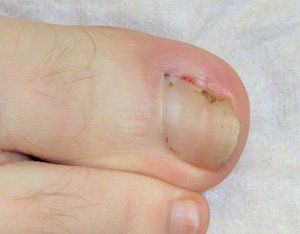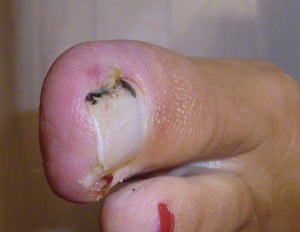Image: You can see an ingrown toenail that was caused by incorrect cutting of the nail. Although no problem was visible on the surface, the patient was in chronic pain. During the operation, moderate pressure with the tweezers was enough to impale the thorn-like remnant of the nail that remained in the depths.
The ingrown toenail is known in medical terminology as unguis incarnatus or onychocryptosis. Although it is not a serious surgical problem, the condition is extremely troublesome for the patient.
An ingrown toenail is usually caused by a nail that curls in at the sides (most frequently)(Unguis convolutus). Here the nail cuts into the surrounding tissue and causes discomfort. The frictional forces caused by walking and running create a wound that can serve as a gateway for germs, resulting in an additional infection. Improper cutting of the toenails can also lead to corners, edges and thorns that injure the tissue.
The ingrown toenail occurs in most cases on the big toe and is more common in men than in women. Children are rarely affected.
Image: Unguis incarnatus (ingrown nail) with matzeration and discrete weeping wound.
At the beginning, unguis incarnatus is characterized by mild but increasing pain. With further strain or use of the forefoot, the irritation increases with redness, swelling, overheating, odor and sometimes bleeding. The transition to infection with the secretion of pus is fluid. If the ingrown toenail is not treated properly, the infection can spread from the forefoot and through the foot into the body. At the latest with the onset of fever and chills as a sign of blood poisoning (sepsis) (extremely rare), there should be no further delay and a doctor should be consulted immediately. In rare cases, an ingrown toenail with infection can also lead to osteomyelitis (bone inflammation). It is best to start treatment at the beginning when the pain becomes more severe in order to prevent the symptoms from progressing.
The causes are manifold.
- The most common cause of unguis incarnatus is improper cutting of the toenails!
- An ingrown toenail often occurs in people with roll nails, where the toenail rolls into the ‘flesh’ at the sides.
- Infections are a common cause. The inflammation causes the tissue to swell and become softer and more vulnerable. As a result, the nail edge causes mechanical irritation and the discomfort described above when walking.
- Injuries can lead to the entry of bacteria and thus to infection.
- An ingrown toenail can also be an indirect consequence of poorly fitting shoes in the forefoot area, which in turn lead to mechanical irritation.
- Chronic fungal infections also promote the development of ingrown toenails.
- Various foot malformations and nail malformations also often promote the occurrence of ingrown toenails.
- Heredity plays an important role.
The ingrown toenail can usually be avoided with the following options.
- It is important to cut the toenails correctly, especially if they are roll nails. If necessary, professional nail care in the form of a pedicure. There must be no sharp corners or edges when cutting. The end of the nail edge must be carefully rounded. It is better to leave the ends of the nails a little longer on the sides, as this prevents them from growing in!
- Mechanical irritation should be avoided. Avoid wearing shoes that are too tight.
- Infections, whether caused by bacteria or fungi, must be treated promptly and appropriately.
- Make sure that your feet are always dry and clean. Wear air-permeable shoes in summer.
Picture: Here the nail edge is causing discomfort on both sides. The incipient infection with redness and swelling is clear.
An ingrown toenail can be treated in different ways. The findings must be taken into account. A doctor should always be contacted in the case of infections!
Tetanus protection
As an ingrown toenail with mechanical irritation and/or infection represents a skin injury, it is important to remember to check the tetanus protection of such patients. If necessary, a booster must be given or if the last booster was given more than 10 years ago, a complete basic immunization must be given (3 injections). If the tetanus vaccination was given 5 years ago, a booster with one injection is sufficient.
Caution secondary diseases
There are various diseases in which an ingrown toenail can quickly develop into a complication. These are diseases (AIDS, chemotherapy for tumors, immunosuppression after transplants) that result in immunodeficiency and therefore poor protection against germs. Diseases that lead to a circulatory disorder, such as diabetes mellitus (diabetes) or PAOD (vascular occlusive disease) also lead to a poor to miserable healing tendency. In these cases, early and possibly more aggressive treatment of ingrown toenails is of crucial importance.
- Correct trimming of toenails. Especially if the ingrown toenail is caused by a thorn or a sharp edge, efficient trimming can be beneficial.
- Wearing wide shoes prevents mechanical irritation in the forefoot area.
- It is also important to protect the affected foot to avoid further mechanical irritation.
- Another option for conservative treatment is the use of toenail clippers (made of metal or plastic). These grip around the toenail and bend the ingrown nail edges sideways upwards so that the nail no longer grows into the tissue. This treatment often takes many months, but does not cause any disability. Sport can also be practiced with this corrective brace.
- Infections can be treated with antiseptic ointments and, if necessary, antibiotics.
- Painkillers are only necessary for severe pain (usually due to infections).
If the conservative treatment options described above are not successful or the ingrown toenail keeps recurring, then surgery should be considered.
There are various surgical techniques that can be used depending on the degree of severity. The smallest possible operation consists of shaping the toenail correctly and cutting away the excess tissue, which can be skin or ‘wild flesh’ (hypergranulation), with a scalpel.
The so-called wedge excision, also known as Emmet plastic surgery, is now presented.
If the minor operation is performed correctly, no recurrence of the unguis incarnatus is generally to be expected. This is due to the fact that the nail root is eradicated at the site where the nail section that grows in is formed.
The operation can be performed under local anesthesia without anesthesia. The anaesthetic is applied via several stitches at the base of the toes. It is important to allow sufficient exposure time afterwards.
The ingrown areas of the nail edge are now removed with a scalpel. This is done lengthwise down to the nail root so that no new nail can grow back in this area. Edges and nail spines, among other things, must be completely removed in depth. After careful rinsing, the wound is closed with stable sutures. The operation is completed with an antiseptic ointment dressing.
After surgery for ingrown toenails, correct follow-up treatment is at least as important to prevent recurrence.
- Without rest, rapid healing cannot be expected. You should therefore walk as little as possible during the healing phase.
- Elevation to reduce swelling should be carried out whenever possible.
- Cooling is particularly useful for mild infections and severe swelling.
- Regular dressing changes to assess proper healing.
- The use of antiseptic ointments kills the germs.
- Antibiotics are given in the event of an infection.
- Painkillers should be available if necessary, at least for the first few days.
Sources:
- Management of the ingrown toenail. – Heidelbaugh JJ, Lee H. – Am Fam Physician. 2009 Feb 15;79(4):303-8. review
- Ingrown toenail or overgrown toe skin?: Alternative treatment for onychocryptosis. – Chapeskie H. – Can Fam Physician. 2008 Nov;54(11):1561-2. review.
- The occasional removal of an ingrowing toenail. – Thommasen HV, Johnston CS, Thommasen A. – Can J Rural Med. 2005 Summer;10(3):173-80. review.
- Practice tips. Managing infected ingrown toenails: longitudinal band method. – Ogur R, Tekbas OF, Hasde M. – Can Fam Physician. 2005 Feb;51:207-8. review .




